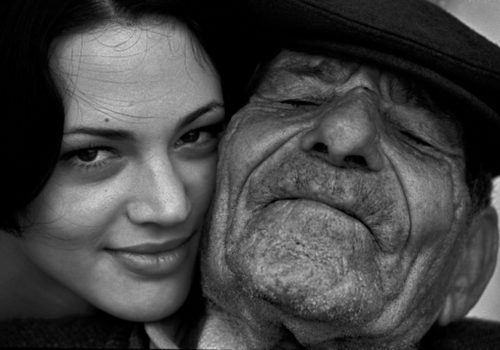Ferdinando Scianna is a storyteller: it has been known for a long time by looking at his pictures story telling Now, thanks to his most recent books, we discover he is also “a writer who has nothing to envy to our contemporary authors”, as the writer Gofferdo Fofi explains. Indeed, after Ti mangio con gli occhi, he just published Visti&Scritti, an interesting combination of texts and photos, in the same book series as In parole by Contrasto.
Visti&Scritti is a book Scianna describes as “difficult to be labeled”: both verbal and visual languages get mixed up in it, involving various types of communications, using multiple levels of language, from the most visual photography to conversations on photography, besides an additional level of non-verbal language.
The book tells the story of the last decades through the author’s personal story and we interviewed Ferdinando Scianna about this. He explains that, “it is a story, a novel in which characters are the people I have met in my life. It’s a kind of self-portrait, created through people I’ve met. They are like mirrors, reflecting my life from the moment our lives met”. Portraits allow Scianna to explore the themes of time flowing and memory, as befits any novel. If it is true, as the photographer says, that “the greatest ambition for a photo is ending in a family album”, Visti&Scritti is the personal album of his career and his life.
“It has often happened, I was dreaming of entering a crowded square, and discovered that there ,were all the people, through which I have lived my life. The living, the dead, my friends and my loved ones, my many masters, and in all of them I could recognize myself, all of them arousing memories, emotions, thoughts. A happy dream. That square became this book “, he says. Thus within the book, as in a virtual square, we can meet famous people (actors, writers, photographers, artists, singers, fashion designers …), as well as his friends and family, and ordinary people. Among them, Giuseppe Tornatore, Scianna’s mother and daughters, Henri Cartier-Bresson, Roland Barthes, Toni Servillo, José Saramago…
These portraits make up the novel of a lifetime, weaving the author’s personal and professional journey. Scianna felt the need to tell a story for each of them, describing their features and the moment of the shooting, the relationship with the person he was portraying, the emotions of that meeting. But how can you shoot a “successful” portrait?
“It affects the photographer, the moment he grasps it, and then the viewer. Not to mention the portrayed subject. It is like a frame that tears apart a portion of time and space. Portrait also correspond to a metaphorical idea of photography, for it was always given so much importance, from Daguerre to the selfie. In an interview I did with Henri Cartier-Bresson, he told me something in apparent contrast with his way of photographing: the portrait needs the question, “I would like to portray you”, because when you take a portrait photo, the subject must be available for it”, Scianna says.
“Photography is equivalent to memory: even if a photo has been taken a few seconds ago, it’s already a record of the past.That very moment, though already fixed, always changes as the viewer himself changes.Photography also changed our way of thinking about memory and its inner workings. Indeed, a portrait includes a constellation of possible memories: those of the subject, of the photographer and of the viewer. So observing is equivalent to imagining, trying to understand what a picture can get across,ready to release its contents of memory. For example, when I look at the unknown girl I portrayed at the subway exit, I wonder about her: where is she, what’s she doing now….it is the sort of “novel” that every picture contains. I’m experimenting with this hybrid communication form that offers a complex evocative reference thanks to photographs and texts crossing and overlapping”, he says.
Moreover, as Manuel Vázquez Montalbán wrote in the preface to the book Le forme del caos by Scianna, “the writer thinks and writes. The photographer thinks while he is taking a photo, so each photo is a thought”.
“Visti&Scritti is an experiment also as a book: though I am connoted as an author of photography and Contrasto as a photographic book publisher, this book has no photos on its cover but words. It fits in the series In Parole: “it’s a “hybrid” series, an attempt to capture new readers beyond those interested in photography. Broadening the knowledge of photography is an idea that we are both interested in me and the publisher because, in spite of everything, it’s one of the most modern languages, even if we often think of it as if it were part of our communication from the very beginning. Anyway, photography has entered into many aspects of communication and of our social life, changing our way of thinking about the past, of telling the present and imagining the future”, Scianna adds.
In this context, the idea of Incontri con la Fotografia was born. They have been held in Rome (Auditorium Fotografia/Auditorium Parco della Musica), to explore the complex relationships between photography and other forms of research and creativity. Scianna met a number of intellectual friends, Edoardo Boncinelli (for science), Goffredo Fofi (for literature), Francesco Merlo (for journalism) and Toni Servillo (on the relationship between photography, theater and cinema), talking to them on how photography changed their spheres of activity.
On his part Ferdinando Scianna has been guest of honor at the 3rd edition of the Ragusa Photo Festival for the first book launch of Visti&Scritti (July 11, 2014).
BOOK
Visti&Scritti
Ferdinando Scianna
Published by Contrasto
432 pages
160x 220 mm
Hard Cover – 24,90 euros
















